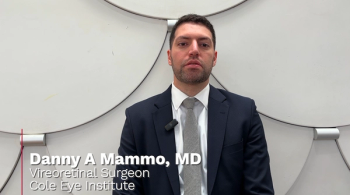
Perfecting the pediatric eye examination
In order to benchmark 20/20 vision in an infant, the testing types and acuity being measured need to be altered.
Reviewed by Jeff Locke MSc, OC (C), COMT.
Improving the pediatric eye examination can be done with several small steps, according to Jeff Locke MSc, OC (C), COMT, a past copresident of the Canadian Orthoptic Society.
Locke, an orthoptist/instructor and team lead in the visual electrophysiology lab at IWK Health in Halifax, Nova Scotia, Canada, discussed the issue of finessing the pediatric eye examination.
Pediatric vision testing
“We can streamline things and make the examination 1% better by being more competent in assessing visual acuity, checking for binocular single vision, and knowing what visual electrophysiology can do in this age group,” said Locke.
In order for vision to be normal, stimuli need to get through our optics to the retina, for the retina to relay to the optic nerve, and for the optic nerve to relay to the cortex.
“Acuity can be based on what aspects of the pathway are stimulated,” Locke explained.
To benchmark 20/20 vision in an infant, the testing types and acuity being measured need to be altered, said Locke.
“We need to shift to more detection-based acuity vs. recognition,” he said.
In preverbal children, forced-choice preferential looking (FPL) tests like Cardiff and Teller are not the most accurate in detecting and managing amblyopia, he pointed out.
Locke noted that it is easy to get complacent with FPL tests and stop documenting those earlier learned tests.
As a child reaches more visual milestones as they age from newborn to 1 year, they can perform more complex testing.
“It does not mean that those tests administered during earlier milestones when a child was younger are no longer useful,” he said. “They can add great qualitative aspects to your vision examination.”
Indeed, vision testing in infants needs to have qualitative more than quantitative assessments, said Locke. A quantitative test like the FPL test serves as a benchmark for normal vision in infants and provides a value over time, he noted. That said, qualitative tests are quick to perform and can aid in detecting asymmetry in vision, Locke said.
In terms of vision assessment tests, Locke pointed to research that concluded optokinetic nystagmus induction methods have been found to be suboptimal in determining visual acuity thresholds. He noted that they can be a great qualitative indicator of the visual pathway as intact pursuit and saccadic centers are needed, as is normal cranial nerve innervation to the extraocular muscles.1
Eye exam strategy for pediatric patients
More recent research2 has suggested a strategy for a pediatric visual acuity examination, Locke pointed out.
“The study authors advised for best compliance to start with binocular visual acuity with Cardiff at 50 cm, followed by induced tropia,” Locke said. “Once these are successfully completed, you can then try monocular visual acuity at 50 cm with your FPL Cardiff test. Their view was assessing both FPL Cardiff at 50 cm and induced tropia allows for more accurate visual assessment and allows practitioners to obtain more information should they lose cooperation from the pediatric patient.”
An educated assumption is being made based on observational data and detection-based acuity with pediatric exams, Locke pointed out.
“When trying to make a comparison between detection-type of acuities, like with forced-choice preferential looking, we are likely overestimating acuity, and it becomes challenging to detect mild to moderate levels of amblyopia,” he said. “Each detection type of acuity has shown validity in assessing the pediatric population, but the sensitivity in detecting amblyopia is variable among tests. None appear to be as robust as crowding-based testing.”
The goal needs to be to maximize the visual examination by combining multiple methods of detection-based testing, not only to increase the sensitivity, but also to gain more general, ocular health knowledge of the pediatric patient, Locke explained.
Binocular assessment
“Do as much binocular assessment as you can while the child is getting comfortable with you, but at the same time, you are extracting data,” he said.
The FPL test outcome should not be the only end point in a pediatric vision assessment, Locke stressed.
“Make your exam 1% better by adding a qualitative measurement into the mix,” he said.
And for those who do not use the FPL test, Locke advised setting a grading standard across the clinic for fixation testing to help follow amblyopia over time, noting that children do not need to be old enough to respond verbally before binocularity is assessed.
There are, however, some objective methods being employed to get a sense of binocularity.
“We can test motor fusion capability in infants, and newer investigations in the use of the FPL test in stereopsis are emerging,” he said.
Detecting stereopsis will help guide a care plan and add confidence to the visual acuity assessment, Locke noted.
Patient cooperation
The challenge with visual electrophysiology in pediatrics is that most of the tests require an infant or toddler who is being assessed to cooperate in order for accurate results to be obtained, making the tests not always practical, with the exception of the electroretinogram (ERG), which can be done under sedation, Locke said.
“The ERG is our bread and butter, but they cannot localize dysfunction specifically to the macula,” he said.
Visually evoked potentials (VEPs) offer an objective measurement at the cortex, but anomalies at any level of the optic pathway (optics, macula, optic nerve, optic pathway) can result in VEP pathology, Locke noted.
Another clinical pearl he offered is that assessors should avoid having their backs turned from their pediatric patients.
“As we all change to an EMR [electronic medical record] and digital visual acuity testing, it is easy to get distracted with screens and turn our backs to patients,” he said. “This limits all observable data that can help guide your examination.”
Locke suggested placing the computer screen where information is being inputted in such a way as to maintain a line of sight to the child being assessed.
Jeff Locke MSc, OC (C), COMT
P: (902) 470-8888
This article is based on a presentation at the virtual 31st annual Jack Crawford Day pediatric ophthalmology update. Locke has no financial disclosures related to this content.
References
1. Kutschke PJ. Preverbal assessment for amblyopia. Am Orthopt J. 2005;55:53-61. doi:10.3368/aoj.55.1.53
2. Nanda KD, Blaha B, Churchfield WT, Fulwylie CR, Medsinge A, Nischal KK. Induced tropia test and visual acuity testing in nonverbal children. J Binocul Vis Ocul Motil. 2018;68(4):134-136. doi:10.1080/2576117X.2018.1525235
Related Content:
Newsletter
Keep your retina practice on the forefront—subscribe for expert analysis and emerging trends in retinal disease management.










































